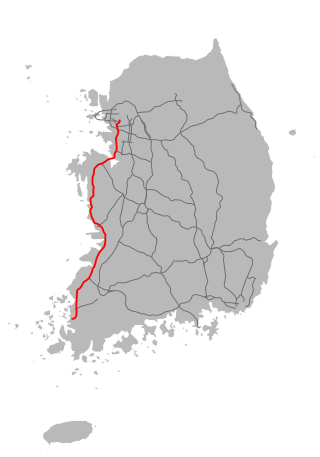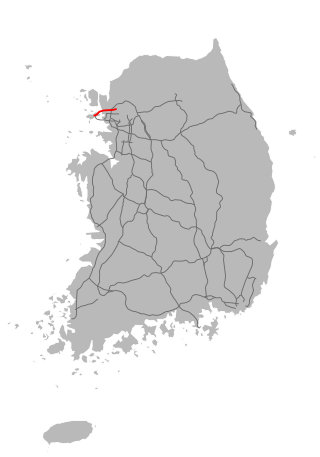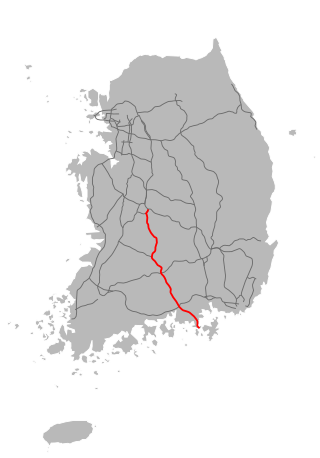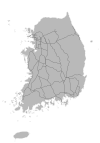Transportation in South Korea is provided by extensive networks of railways, highways, bus routes, ferry services and air routes that traverse the country. South Korea is the third country in the world to operate a maglev train, which is an automatically run people mover at Incheon International Airport.

The Gyeongbu Expressway is the second oldest and most heavily travelled expressway in South Korea, connecting Seoul to Suwon, Daejeon, Gumi, Daegu, Gyeongju, Ulsan and Busan. It has the route number 1, signifying its role as South Korea's most important expressway. The entire length from Seoul to Busan is 416 kilometers (258 mi) and the posted speed limit is 100 kilometers per hour (62 mph), enforced primarily by speed cameras.

The Seohaean Expressway, meaning "West Coast Expressway", is a freeway in South Korea, connecting Mokpo to Gunsan, Dangjin, and Seoul.

The Incheon International Airport Expressway is an expressway in South Korea connecting Incheon International Airport to Goyang, Gyeonggi.

The Jungbu Naeryuk Expressway is an expressway in South Korea. Numbered 45, it was first constructed in three parts: connecting Yangpyeong to Chungju and Sangju to Gimcheon and Hyeonpung to Changwon. The part of the expressway between Chungju and Sangju was completed at the end of 2004, with the last remaining section being that between Gimcheon and Hyeonpung. The Jungbu Naeryuk Expressway Branch Line is route number 451 and connects Hyeonpung to N. Daegu.

The Yeongdong Expressway is an expressway in South Korea. Numbered 50, it connects the Seoul area with Gangwon Province. It is named from Yeongdong, an old name for Gangwon. The road has its western end in Namdong-gu of Incheon Metropolitan City. Its eastern end lies in Gangneung near the east coast. From Incheon to Gangneung, the expressway covers 234.39 kilometers.

The Jungbu Expressway (Korean: 중부고속도로) is an expressway in South Korea. Numbered 35, it connects Cheongju to Hanam. The expressway's route number is 35, which it shares with the Tongyeong–Daejeon Expressway. This expressway joins the Gyeongbu Expressway at Cheongju and they divide again at Daejeon.

The Capital Region First Ring Expressway (Formerly as Seoul Ring Expressway) (Expressway No.100) (Korean: 수도권제1순환고속도로; RR: Sudogwon Je1sunhwan Gosokdoro) is an expressway, circular beltway or ring road around Seoul, South Korea. It connects satellite cities around Seoul, Ilsan, Namyangju, Hanam, Pyeongchon, Jungdong, Bundang, Pangyo, Sanbon and Gimpo. The expressway runs 127.6 km. Seoul Ring Expressway is currently under construction to widen the expressway between Anhyeon Junction to Seongnam which is expected to be finished in 2016.
The Pyeongtaek–Jecheon Expressway(Korean: 평택제천고속도로; Hanja: 平泽堤川高速道路; RR: Pyeongtaek-Jecheon Gosok Doro), Route 40, is an expressway in South Korea, currently connecting Pyeongtaek, Gyeonggi Province to Jecheon, North Chungcheong Province with planned extensions to Jecheon, Samcheok.

Donghae Expressway is an expressway in South Korea, connecting Busan to Sokcho. It is numbered 65 and it is planned to eventually extend all the way along the east coast to Haeundae, Busan. Its current length is 62.1 kilometres (38.6 mi), and It is part of the Asia Highway Route 6.
The Second Gyeongin Expressway is an expressway in South Korea, connecting Incheon to Seongnam. It is numbered 110 and has a length of 67.8 km. In Incheon International Airport to Hakik JC, It connected by Incheon Grand Bridge(인천대교).

The Seoul–Yangyang Expressway (Korean: 서울양양고속도로) is an expressway in South Korea, connecting the cities of Seoul and Yangyang County. It is 78.5 kilometers long, with two lanes of traffic in each direction and ten interchanges. It shares the number "60" and operates by Seoul-Chuncheon Highway Corporation, as a privately financed toll road. The extension to the end at the eastcoast is to be opened June 30, 2017.

The Tongyeong–Daejeon Expressway (Korean: 통영대전고속도로) is an expressway in South Korea. It connects Tongyeong to Daejeon. The expressway's route number is 35, which it shares with the Jungbu Expressway. This expressway joins the Gyeongbu Expressway at Cheongju and they divide again at Daejeon.

National Route 6 is a major highway on the Korea It connects Incheon with the city of Gangneung, Gangwon Province,

National Route 7 is a national highway in South Korea. It connects Busan with Goseong in Gangwon Province. Before the division of the Korean Peninsula, the highway ran until Onsong, North Hamgyong Province, in present-day North Korea.

Pyeongtaek–Paju Expressway is an expressway in South Korea. It connects Pyeongtaek to Paju in Gyeonggi Province. The expressway's route number is 17, which it shares with the Iksan–Pyeongtaek Expressway. This expressway overlaps with the Capital Region Second Ring Expressway at Hwaseong.

Yongin–Seoul Expressway is an expressway in South Korea, connecting Yongin, Gyeonggi and Gangnam-gu, Seoul. Informally known as the Gyeongsu Expressway(Korean: 경수고속도로), it is the only expressway in South Korea not directly connected to another expressway. Although it shares the same designation number, it is not directly connected to Osan-Hwaseong Expressway either. Plans have been made to connect the Busan side of Gyeongbu Expressway and Yongin-side Geumto Tollgate.
The Seobu Urban Expressway is 4-lane highway located in Seoul. South Korea. and part of National Route 1.
The Sejong–Pocheon Expressway, is an expressway in South Korea, connecting Anseong to Guri, Seoul, Namyangju, Uijeongbu and Pocheon.
Seosan–Yeongdeok Expressway also known as 6th East–West Expressway is an expressway in South Korea connecting Dangjin to Yeongdeok County.




















